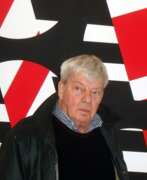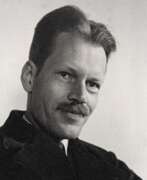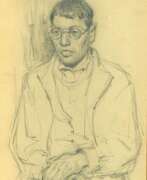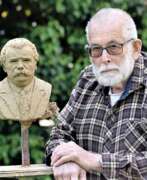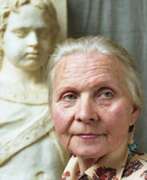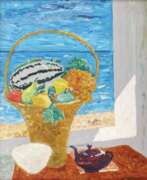Monumentalists 20th century


Wäinö Waldemar Aaltonen was a Finnish artist and sculptor, celebrated for his contributions to the cultural landscape of Finland, particularly during the early years of the nation's independence. Born in 1894, Aaltonen's works are distinguished by their nationalist themes and monumental scale, often reflecting the spirit and identity of Finland. His artistic journey was notably influenced by a trip to Italy in 1923, where he encountered cubist and futurist art, elements of which he integrated into his own work.
Aaltonen's sculptures are key features in Finland's public spaces, including the well-known statues in the House of Parliament and numerous works in Turku, such as the "Lily of Turku" and a statue of the runner Paavo Nurmi. His mastery is also showcased at the Wäinö Aaltonen Museum of Art in Turku, which houses a significant collection of his sculptures, paintings, and drawings. This museum not only celebrates his legacy but also serves as a central repository for his extensive works, donated by Aaltonen himself.
For those interested in exploring Aaltonen's work and the impact of Finnish sculpture, a visit to the Wäinö Aaltonen Museum of Art is invaluable. The museum provides a comprehensive view of his artistic evolution and contributions to Finnish art. For updates on exhibitions and events related to Wäinö Aaltonen, consider signing up for notifications through the museum's mailing list, ensuring you stay informed about new insights and offerings related to this pivotal artist.


Ivan Osipovich Akhremchik (Russian: Ива́н О́сипович Ахре́мчик) was a twentieth-century Belarusian Soviet artist. He is known as a painter and teacher.
Ivan Akhremchik worked in the genres of portrait, thematic painting, landscape and monumental art. He was one of the first Belarusian artists turned in his work to the theme of the establishment of Soviet power and socialist construction in Belarus. As a muralist, the artist participated in the creation of several pictorial panels for exhibitions and cultural institutions of Belarus.
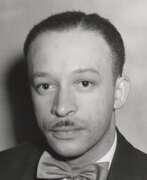

Charles Henry Alston was a mid-twentieth-century American artist. He is known as a graphic and muralist painter as well as a sculptor, illustrator, and educator who lived and worked in New York City's Harlem neighborhood.
Charles Alston was an activist in the so-called "Harlem Renaissance." He became the first African-American director of the U.S. Federal Art Project. The artist created murals for Harlem Hospital as well as a number of cultural and administrative buildings in New York City. Alston is the author of a bust of Martin Luther King, Jr. which was the first depiction of an African American to be displayed at the White House in Washington, DC.


Nikolai Ivanovich Andronov (Russian: Николай Иванович Андронов) was a Soviet artist of the second half of the twentieth century. He is known as a painter, muralist and teacher, considered one of the founders of the "severe style" in the art of the USSR.
Nikolai Andronov actively worked to liberalize the Soviet art scene. At the beginning of his career, he created thematic paintings, later focusing on landscapes. The artist was also involved in the decoration of buildings, including the clubhouse of the Soviet Embassy in the United States, the Paveletsky Railway Station and subway stations in Moscow. From 1992, he taught at the Surikov Moscow Art Institute and headed the composition department.


Mikhail Konstantinovich Anikushin (Russian: Михаил Константинович Аникушин) was a Soviet and Russian sculptor, celebrated for his monumental works that have left a lasting legacy in the art world. Born on September 19, 1917, in Moscow, Anikushin's sculptures are a testament to his profound skill and dedication to depicting historical and cultural figures with a dynamic expressiveness that brought them to life. His most notable works include monuments dedicated to Alexander Pushkin, found at the Pushkinskaya Station of the Saint Petersburg Metro and Arts Square in Saint Petersburg, as well as a monument to Vladimir Lenin at Moskovskaya Square in Saint Petersburg.
Anikushin's career was distinguished not only by his artistic achievements but also by the honors he received, reflecting the impact of his work on Russian culture. He was awarded the title of "Honored Artist of the RSFSR" in 1957, "People's Artist of the USSR" in 1963, and became a full member (academician) of the Russian Academy of Arts in 1962. His dedication to capturing the spirit and essence of his subjects, particularly Alexander Pushkin and Vladimir Lenin, showcases his innovative approach to sculpture, moving beyond traditional standards to depict his subjects in active, dynamic poses.
The Presidential Library collection dedicated to Anikushin commemorates the 100th anniversary of his birth, highlighting his significant contributions to Russian sculpture in the 20th century. Anikushin's works are integral to the aesthetic and cultural landscape of Leningrad (now Saint Petersburg), contributing to the city's historical and artistic identity. The collection also emphasizes his role in the community, including his public service and the enduring influence of his artistic vision on generations to come.
Collectors and experts in art and antiques recognize Mikhail Konstantinovich Anikushin not only for his technical prowess but also for his ability to imbue his sculptures with a sense of movement and emotional depth that resonates with viewers. His works remain landmarks, celebrated both in Russia and internationally, for their contribution to the cultural heritage.
For those interested in exploring the works and legacy of Mikhail Konstantinovich Anikushin further, signing up for updates can provide invaluable insights into new discoveries, exhibitions, and auction events related to this influential sculptor. This subscription is an opportunity to stay informed about the sales and exhibitions that continue to celebrate Anikushin's remarkable contribution to the world of sculpture.


Boris Vladimirovich Arakcheyev (Russian: Борис Владимирович Аракчеев) was a Soviet and Belarusian artist of the second half of the twentieth and early twenty-first centuries. He is known as a painter and teacher.
Boris Arakcheyev worked in easel painting in the genres of landscape, still life, thematic paintings and battle scenes. A series of portraits of contemporaries and famous people occupies a special place in his creative heritage. He also worked in monumental painting - he was one of the creators of the diorama "Minsk Cauldron" in the Museum of the History of the Great Patriotic War of Belarus.


Robert Petrosovich Avakyan (Russian: Роберт Петросович Авакян) was a Soviet and Uzbek artist of the second half of the twentieth and early twenty-first centuries of Armenian origin. He is known as a painter, graphic artist, sculptor and teacher.
Robert Avakyan was trained in painting, but he is most famous as an author of monumental sculptures. He worked actively in Tashkent, participating in numerous exhibitions, including international sculpture competitions. The master also left his mark in such Uzbek cities as Bukhara, Nukus and Yangibazar, where he created significant monumental works.


Zair Isaakovich Azgur (Russian: Заир Исаакович Азгур) was a Soviet and Belarusian artist of the twentieth century. He is known as a sculptor, art historian and writer.
Zair Azgur worked in the field of easel and monumental sculpture. He created sculptural portraits of figures of the socialist and revolutionary movement, historical figures, famous masters of culture, as well as monuments. Azgur was an adherent of strict realistic form in art.


Ekaterina Feodorovna Belashova (Russian: Екатерина Фёдоровна Белашова) was a Russian sculptor renowned for her profound contributions to Soviet sculpture. Born in St. Petersburg in 1906, she later moved to Moscow to further her education and career. Belashova began her artistic journey at VKHUTEIN, studying under notable figures such as R. Bach and A. Matveev. Her career saw her become a revered professor at the Moscow Institute of Applied and Decorative Arts and the Moscow School of Industrial Arts.
Her works, celebrated for their delicate silhouettes and meticulous attention to proportions, delve into the emotional and physical resilience of individuals, particularly during the turbulent times of war. Belashova's sculptures often embody the spirit of her era, exploring themes of loss, hope, and the enduring strength of the human spirit. Notable works include "The Fighter," "Unvanquished," and a series dedicated to the memory of the victims of fascism, showcasing her ability to capture the essence of her subjects with both sensitivity and strength.
Belashova's sculpture, "Girl with a garland in her hair," exemplifies her skill in capturing youth and vitality, showcasing a young girl in a moment of introspection and grace. This piece highlights Belashova's mastery over bronze, a material she often utilized despite its scarcity in the post-war period.
Throughout her life, Belashova remained deeply connected to the art world, not only through her creations but also as an educator and influencer in the Soviet art scene. Her contributions were recognized with numerous awards, including the prestigious State Prize of the USSR. Belashova's legacy is one of artistic excellence and profound humanity, leaving an indelible mark on the world of sculpture.
For collectors and experts in art and antiques, Ekaterina Feodorovna Belashova's work offers a deep dive into the rich tapestry of Soviet-era sculpture, characterized by its emotional depth and aesthetic finesse. Sign up for updates on new product sales and auction events related to Ekaterina Feodorovna Belashova, and explore the enduring beauty of her contributions to the world of art.
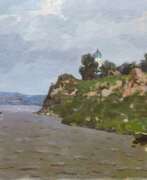

Yakov Tarasovich Besperstov (Russian: Яков Тарасович Бесперстов) was a Russian Soviet artist of the second half of the twentieth century. He is known as a painter, muralist, representative of the Leningrad school of painting.
At the initial stage of his career, Yakov Besperstov worked in the field of monumental and decorative painting, participating in the painting of various buildings. Later he moved to easel painting, creating portraits, genre paintings, as well as urban landscapes. His works were exhibited at exhibitions from the late 1950s and were appreciated by leading artists of Leningrad. The master traveled extensively throughout various regions of Russia and other countries, including France.
His works are in museums and private collections in various countries, including Russia, France, Belgium, Germany, Spain and Italy.
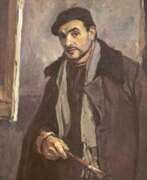

Alexander Alexandrovich Blinkov (Russian: Александр Александрович Блинков) was a Soviet and Russian artist of the twentieth century. He is known as a painter, graphic artist and teacher.
Alexander Blinkov painted genre and battle paintings, portraits, landscapes, animalistics, and also created dioramas and panoramas. Among the famous works of the artist are the paintings "The Taking of Vyborg by Soviet troops", "Partisan Trails", "Kursk Bulge", "Naval Maneuvers", panorama "Defense of Petrograd", diorama "Battle of Stalingrad" and others.
Blinkov actively taught and was associated with the Higher Art and Industrial School in Leningrad. His works are in museums and private collections in Russia, Japan, France, Ukraine, Germany and other countries.


Ivan Ivanovich Chorny (Russian: Иван Иванович Чёрный) was a Soviet, Ukrainian and Russian artist of the second half of the twentieth and early twenty-first centuries. He was known for his monumental and decorative works in the style of socialist realism.
Ivan Chorny reoriented his style in the late 1990s, inventing a new technique and moving away from figurativeness in favor of abstract painting. His enigmatic compositions became an expressive expression of inner feelings enriched with colors and lines.


Isaac Aronovich Davidovich (Russian: Исаак Аронович Давидович) was a Soviet and Belarusian artist of Jewish origin of the second half of the twentieth century. He is known as a painter and graphic artist.
Isaac Davidovich worked in easel and monumental and decorative painting, as well as in easel and book graphics, he drew illustrations and posters. In the field of monumental art he created plafonds and panels.


Raoul Dufy, a renowned French artist, is celebrated for his vibrant and decorative style, which left a significant mark in the realms of Fauvism and Post-Impressionism. Born in 1877 in Le Havre, France, Dufy's artistic journey was profoundly influenced by Henri Matisse's Fauvist work "Luxe, Calme et Volupté," which he encountered at the Salon des Indépendants in 1905. This experience steered him towards Fauvism, a style that emphasized bold contours and bright colors.
Dufy's artistic evolution saw him briefly embrace Cubism around 1920, after which he developed a unique approach. This approach, often referred to as stenographic, was characterized by skeletal structures, foreshortened perspectives, and the use of thin, quickly applied washes of color. His works, known for their cheerful and fashionably decorative nature, often depicted scenes of leisure like yachting, the French Riviera, and chic parties, capturing the essence of the period's optimism.
In addition to his painting, Dufy was also a commercial artist, illustrator, and designer, contributing significantly to textile design and public murals. His large-scale public art commissions combined modern and allegorical subjects with exuberant outlines and intense colors, showcasing a modernist take on traditional mural work. Notable works by Dufy include "The Regatta," "The Harvester," and the monumental "The Electricity Fairy," a large mural commissioned for the 1937 World's Fair in Paris.
His works are housed in prestigious public collections worldwide, including the Art Institute of Chicago, the Musée d'Art Moderne de Paris, and the National Gallery of Art in Washington, D.C. Despite his artistic achievements, Dufy's focus on decorative art and the lack of engagement with wider social concerns has led to a varied critical reception of his work. Nonetheless, his contribution to 20th-century art, particularly in popularizing a vibrant and illustrative style, remains undisputed.
If Raoul Dufy's artistry captivates you and you wish to stay informed about the latest artworks, exhibitions, and auction events related to this remarkable artist, we invite you to sign up for our updates. By subscribing, you'll receive timely notifications about new pieces for sale and upcoming auctions. This is a wonderful opportunity for collectors and art enthusiasts to enhance their appreciation and possibly their collections of Dufy's work. Stay connected with the world of art and don't miss any chance to acquire unique pieces by this celebrated artist.


Valery Arutyunovich Geghamyan (Russian: Валерий Арутюнович Гегамян) was a Soviet and Ukrainian artist of the mid-twentieth century of Armenian origin. He is known as a painter, graphic artist and teacher.
Valeriy Geghamyan became famous for his monumental canvases, large thematic cycles and graphic series. He also created portraits, landscapes and still lifes. Since the early 1960s he lived and worked in Odessa and founded the art and graphic arts faculty at the Odessa Pedagogical Institute, where he taught for more than 20 years. The master raised many famous artists, some of whom are also teachers, passing on the experience of their teacher.


Oswaldo Guayasamín is an Ecuadorian painter, muralist and sculptor.
Oswaldo's father was an Indian, and the family was very poor, but the future artist was educated at the School of Fine Arts of Quito. Soon, literally in two years, he created a cycle of 103 paintings dedicated to the life of oppressed Indians in Latin America. Oswaldo Guayasamin also painted portraits of famous contemporaries, including Fidel Castro, whom he admired. He also created murals, frescoes, landscapes, and symbolic images.
The artist's works were exhibited in Paris, Moscow and in Leningrad, among other cities around the world, with amazing success. In 1957, at the Fourth Biennial in São Paulo, he was named the best South American artist.
Guayasamin was also a passionate collector. In 1978, the then famous artist donated to the State of Ecuador some 500 colonial paintings and sculptures, pre-Columbian archaeological sites, Goya and Picasso paintings that he had collected.


Theodor Theodorovich Herzen (Russian: Теодор Теодорович Герцен) was a Soviet and Kyrgyz artist of the second half of the twentieth and early twenty-first centuries of German origin. He is known as a painter, graphic artist, muralist, who was honored with the title of People's Artist of Kyrgyzstan.
Theodor Herzen worked in monumental and decorative art, easel painting and book graphics. One of Herzen's outstanding works was a monumental cycle of illustrations to the Kyrgyz epic "Manas", including more than two hundred linocuts. In this project, he combined his extensive experience of working on Kyrgyz themes with his deep knowledge of the ethnicity, history and spiritual traditions of the Kyrgyz people. Herzen collected extensive ethnographic material and created many sketches of costumes and scenes from Kyrgyz life for this cycle of illustrations.


Nida Kadhim is an Iraqi sculptor, noted for producing a number of monumental works for Baghdad's city centre, some of which are still standing, while others were demolished or looted following the 2003 Iraqi invasion. Kadhim received his formal art education at Baghdad's Academy of Fine Arts in the 1950s. Actively involved in the Iraqi arts community, he became a founding member of the art group known as Al-Mujadidin (The Innovationists). His sculptures focus on grandiose busts and statues of leading figures taken from Iraq's history, or are based on other themes the artist considers worthy. His most well-known sculpture, which is still standing, is the Arab Woman in Zawra Park, Baghdad. It depicts an Arab woman holding a bouquet of flowers out to the new generation of Iraqis who are seeking a better future.


Alexander Mikhailovich Kishchenko (Russian: Александр Михайлович Кищенко) was a Soviet and Belarusian artist of the second half of the twentieth century. He is best known as a muralist painter.
Alexander Kishchenko is considered one of the most famous artists of Belarus of the 20th century, and his works are valuable assets of Belarusian culture. He worked in all genres of easel and monumental decorative painting and created hundreds of works during his career, including philosophical paintings and portraits. The artist was also proficient in mosaics, ceramics and tapestry.


Louis Kolitz was a German painter of the second half of the nineteenth and early twentieth centuries. He is known as a painter who specialized in depicting historical events, battles, as well as portraits and landscapes.
Kolitz worked primarily in the portrait genre, but he also created monumental works, including murals for official buildings. His portraits and paintings were characterized by realism, detail and mastery of tone, which brought him popularity. Today, his work is recognized as more significant than just the landscape studies and Impressionist paintings of the 1870s. Although critics estimate that Kolitz may have been a pioneer and founder of German Impressionism, he only gained greater fame after his posthumous exhibition in Munich in 1920.


Yuri Konstantinovich Korolyov (Russian: Ю́рий Константи́нович Королёв) was a distinguished Soviet painter, monumental artist, and educator, renowned for his contributions to the art world. Born in 1929 and passing in 1992, Korolyov's career was marked by a profound dedication to the exploration of monumental and decorative compositions, painting, mosaics, and stained glass. His notable achievements include being honored as the People's Artist of the USSR in 1985 and serving as a corresponding member of the Academy of Arts of the USSR since 1983. Korolyov's influence extended beyond his artwork, as he was an esteemed professor at the Higher School of Industrial Art, where he shaped the minds of future artists, and notably held the position of Director at the Tretyakov Gallery from 1980 to 1992.
Korolyov's works are celebrated for their intricate detailing and profound thematic depth, capturing the essence of Soviet ideology through art. His masterpiece, "50 years of the USSR" in Tolyatti, created in 1981, stands as a testament to his skill in creating monumental art that resonates with historical significance and artistic beauty. This piece, among others, showcases Korolyov's mastery in blending artistic innovation with national pride, making his contributions invaluable to the Soviet art scene and beyond.
For art collectors and enthusiasts keen on exploring the works of a visionary who played a pivotal role in Soviet art history, Yuri Konstantinovich Korolyov's legacy offers a rich tapestry of cultural and artistic significance. His dedication to art education and his monumental contributions to the USSR's artistic heritage underscore the profound impact he had on the art world.
To stay updated on exhibitions and sales related to Yuri Konstantinovich Korolyov, signing up for updates is highly recommended. This subscription ensures that collectors and experts are informed about new opportunities to engage with Korolyov's enduring legacy, including upcoming auctions and events.
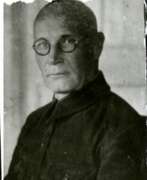

Georgy Dmitrievich Lavrov (Russian: Георгий Дмитриевич Лавров) was a Russian and Soviet sculptor of the twentieth century. He is known as a portraitist, monumentalist, animalist and representative of the Art Deco style.
Georgy Lavrov created propaganda posters at the beginning of his career in collaboration with poet Vladimir Mayakovsky. He then developed his style during a business trip to Paris under the influence of the French animalist sculptor François Pompon. Returning from France in 1935, he created the famous sculptural composition "Thank you Comrade Stalin for our happy childhood!". However, in 1938 the artist was arrested and convicted, served his sentence in the camps, and in 1954 was rehabilitated.
Lavrov left a significant artistic legacy.
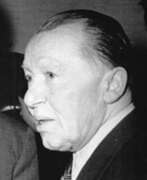

Max Lingner was a German artist of the first half of the twentieth century. He is known as a painter, graphic artist, muralist and teacher.
Max Lingner at the beginning of his career, studying in Paris, was influenced by Impressionism. He worked as a painter and engraver for the newspaper Le Monde. Joining the French Communist Party, Lingner fought on the Republican side during the Spanish Civil War and fought against the Nazis in the Resistance Movement in France. After returning to the GDR, he became a professor and created the monumental panel "Building the Republic" in the House of Ministers. The artist donated the 40 paintings, prints and watercolors he had brought back to the state.


Pyotr Tarasovych Maltsev (Russian: Пётр Тарасович Мальцев) was a distinguished Soviet artist, celebrated for his mastery in socialist realism. Born on December 17, 1907, in Mariupol, Maltsev carved a niche for himself in the art world through his profound works that often depicted the valor and spirit of the Soviet people during significant historical events. His art education was rooted in the traditions of the Zaporozhe Art School and further honed at the VKhUTEIN, under the guidance of notable Soviet artists such as P.V. Kuznetsov and V.A. Favorsky.
Maltsev's oeuvre includes a plethora of works ranging from paintings and posters to monumental dioramas, with notable pieces like “The Storm of Sapun Ridge,” which vividly captures the intensity of the Battle of Sevastopol. His art, imbued with the ethos of socialist realism, strives to embody the heroism and resilience of the Soviet populace amidst the trials of war and the pursuit of socialism.
His contributions to Soviet art were not only recognized by his contemporaries but continue to be revered today, with many of his works being housed in prestigious institutions such as the State Tretyakov Gallery and the Central Naval Museum. Maltsev's legacy extends beyond the canvas, encapsulating the spirit of an era and continuing to inspire generations. His passing on October 5, 1993, marked the end of a remarkable chapter in Soviet art history, but his works live on, offering a window into the Soviet soul and its indomitable will.
For collectors and experts in art and antiques, Maltsev's body of work presents a unique insight into the Soviet aesthetic and ideological landscape. To stay updated on new product sales and auction events related to Pyotr Tarasovych Maltsev, subscribing for updates is highly recommended. This subscription ensures that enthusiasts are well-informed of the latest developments and opportunities to engage with Maltsev's enduring legacy.


Matvey Genrikhovich Manizer (Russian: Матвей Генрихович Манизер) was a distinguished Russian sculptor, celebrated for his contributions to socialist realism. Born on March 17, 1891, in Saint Petersburg, Manizer emerged from a family deeply rooted in the arts, his father being a renowned Baltic German artist. His educational journey at the Saint Petersburg State Artistic and Industrial Academy and the art school of the Peredvizhniki honed his skills, leading him to become a seminal figure in Soviet art. Manizer's move to Moscow in 1941 marked a pivotal phase in his career, where he continued to produce significant works that were distributed across the Soviet Union, including multiple portrayals of Lenin.
Manizer's style, deeply academic and realistic, was instrumental in capturing the ethos of an era, making him a key proponent of socialist realism. His monumental works, such as the Monument to V. Volodarsky in Leningrad and the series of 80 bronzes for the Moscow Metro station Ploshchad Revolyutsii, are testaments to his mastery and ideological commitment. His achievements earned him the title of People's Artist of the USSR in 1958, among other accolades, highlighting his influence in the Soviet art scene.
The legacy of Matvey Manizer is not just limited to his sculptures; it extends through his family, with his wife Yelena Yanson-Manizer and their son Gugo Manizer continuing the artistic tradition. Manizer's work remains a pivotal part of Russian cultural heritage, exhibited in various public spaces and commemorating figures and events that shaped Soviet history.
For collectors and experts in art and antiques, Manizer's work offers a deep dive into the artistic narratives of the 20th century, especially within the Soviet context. His sculptures serve as historical markers, blending artistic merit with ideological narratives. For those interested in exploring more about Manizer's contributions and his role in Soviet art, subscribing for updates on new product sales and auction events related to Matvey Genrikhovich Manizer is highly recommended. This subscription will keep you informed about opportunities to own a piece of this monumental artist's legacy.
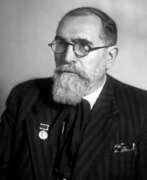

Sergey Dmitrievich Merkurov (Russian: Серге́й Дми́триевич Мерку́ров) was a Soviet sculptor-monumentalist of Greek-Armenian descent, celebrated for his significant contributions to the art world. Born in Alexandropol (now Gyumri), he ventured into art after leaving the Kyiv Polytechnic Institute due to a political scandal. Merkurov's education in art took him across Europe, from Adolf Meyer's tutelage in Switzerland to the esteemed studio of Auguste Rodin in Paris. His acquaintance with Vladimir Lenin abroad influenced his later works, including the famed Lenin statues across Soviet territories. Merkurov's mastery in creating post-mortem (death) masks for notable figures such as Leo Tolstoy and Vladimir Lenin, among others, showcases his exceptional talent and innovation in the field.
An adept of "academic modernism," Merkurov was also involved in the "Monumental Propaganda" program, through which he created numerous significant monuments, including the largest Stalin statues in the USSR. His works, such as the "Shooting of 26 Baku Commissars" and the "Death of the Leader," reflect his artistic prowess and ideological commitment to Soviet monumentalism.
Merkurov's legacy is preserved in the Merkurov Museum in Gyumri, which houses an extensive collection of his death masks, including the only original death mask of Lenin. This museum, opened in 1984 in his family house, stands as a testament to his life's work and influence. His contributions were recognized with titles such as People's Artist of the USSR and membership in the USSR Academy of Arts. Merkurov's works are part of several museum collections, including the State Tretyakov Gallery, underscoring his lasting impact on Russian and Soviet art.
Collectors and art and antiques experts who appreciate the depth of Soviet-era monumental art would find Sergey Dmitrievich Merkurov's works a remarkable study. For updates on exhibitions and auctions featuring Merkurov's work, sign up for notifications to stay informed about new sales and events related to this influential artist.
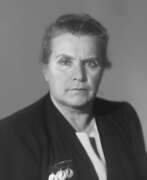

Vera Ignatyevna Mukhina (Russian: Ве́ра Игна́тьевна Му́хина) was a renowned Soviet sculptor and artist, celebrated for her significant contributions to Soviet art and sculpture. Born into a wealthy merchant family in Riga, Mukhina's journey into the world of art took her through the studios of notable artists in Russia and Europe, including the Académie de la Grande Chaumière in Paris under Antoine Bourdelle. Her work is deeply imbued with a sense of national pride and a commitment to the socialist cause, reflecting the tumultuous times she lived through, including both World Wars and the shifting political landscape of the Soviet Union.
Mukhina's most celebrated piece, "Worker and Kolkhoz Woman," a towering sculpture made of stainless steel, was originally created for the 1937 World's Fair in Paris. This sculpture, standing as a symbol of Soviet might and unity, showcases Mukhina's mastery in welding and her innovative approach to monumental art. The piece was acclaimed internationally and continues to be a significant symbol of Soviet and Russian culture.
Throughout her career, Mukhina experimented with a variety of materials and techniques, including glass, earning her numerous awards, such as the Stalin Prize, which she received five times, and the title of People's Artist of the USSR. Her commitment to art went beyond her own creations; she was a passionate educator and theorist, advocating for the enrichment of Soviet artistic vocabulary and experimenting with new materials and forms.
Mukhina's legacy extends beyond her sculptures to her contributions to the art world through her theoretical writings, her influence on public and architectural sculpture, and her experimentation with art glass, transforming ordinary objects into decorative art pieces. Her works are preserved in museums and public spaces, continuing to inspire and evoke admiration.
For collectors and experts in art and antiques, Mukhina's works represent a poignant narrative of 20th-century Soviet art, characterized by its boldness, innovation, and ideological commitment. Her life's work offers a window into the complexities of Soviet art, navigating the realms of personal expression and state expectations.
For those interested in exploring Vera Ignatyevna Mukhina's significant contributions to art and sculpture, consider signing up for updates on new product sales and auction events related to her work. This subscription offers a unique opportunity to engage with the history and legacy of one of the 20th century's most influential artists.


Kenton Nelson is an American muralist, graphic designer, illustrator and educator.
A graduate of California State University, Nelson also studied at Otis College of Art and Design in Los Angeles, California. He later taught there as well.
He first worked as a graphic designer and illustrator for many years before he began painting in the style of modern realism. In his paintings, one can see the influence of 1950s American advertising and pop art. Nelson also creates wall murals. In 2005, he published a two-volume set of art books entitled Rhyme and Reason, Prose and Minuses.
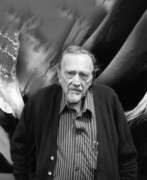

Leonardo Nierman, full name Leonardo Nierman Mendelejis, is a Mexican artist known mainly for his paintings and sculptures. His work is abstract yet still contains visible images of nature such as birds, water, lightning and more. His paintings are in pure colours, while his sculptures are usually in metal, often with a silver hue.


Karl Ulrich Nuss is a German artist and sculptor who creates large-scale bronze compositions.
His father was the sculptor Fritz Nuss (1907-1999), Karl Ulrich Nuss continued his work and developed an unmistakable design style that characterizes all his sculptures. They depict single people, couples, families, as well as new fantastical creations from the animal kingdom. These works can be seen in public spaces in Bochum, Frankfurt/Main and Stuttgart.


August Friedrich Pecht was a German painter of the second half of the nineteenth and early twentieth centuries. He is known as a historical painter and portraitist, lithographer, as well as an art historian and scientific writer.
Pecht's works depicted scenes from the lives and works of famous German writers and historical figures. His most famous paintings include scenes featuring Goethe, Schiller, Henry VIII, and others. Pecht also illustrated various publications and wrote more than 1,500 articles on art. He also left his mark on art with monumental painting, notably decorating the frescoes of the city council hall in Constance.






































